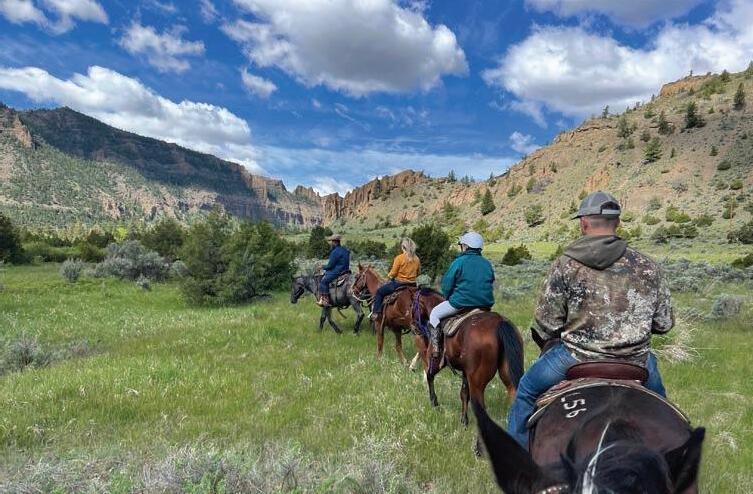
28 minute read
Cody, Wyoming
Story and photographs by KRIS GRANT
It’s a wild and wonderful gateway to Yellowstone (but you may not want to leave town!)
Ready to visit a destination filled with thrilling outdoor adventures, rodeo action every night and five captivating scenic byways? How ‘bout a spot where the spirit of the American West is alive and well? Last, but not least, a small-town city with America’s first national park, Yellowstone, in its backyard.
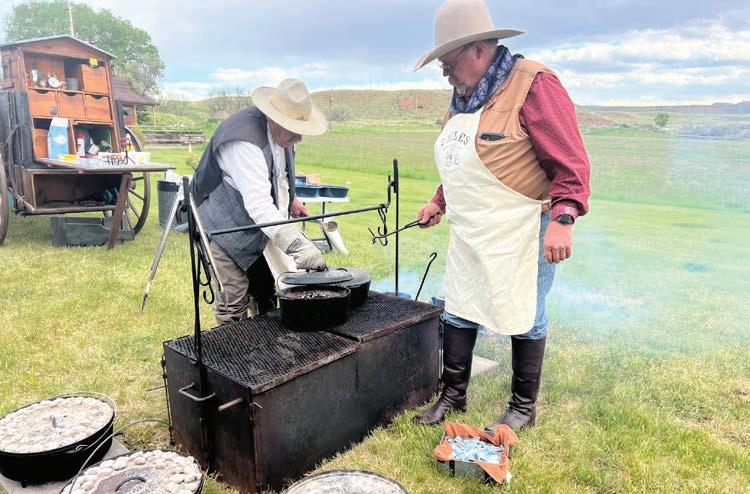
Let me introduce you to Cody, Wyoming, founded in 1896 by America’s larger-than-life showman and bison hunter, William F. “Buffalo Bill” Cody. It is situated along the Shoshone River in the Bighorn Basin of Northwest Wyoming.
I first motored into Cody in 2008 while on a cross-country RV trip. During my visit, I explored the impressive Buffalo Bill Center of the West, but I missed the Cody Nite Rodeo. I made a mental note to return soon and experience more of what this cowboy town has to offer. “Soon” turned out to be a 16-year hiatus. But lucky for me, the Western Chapter of SATW (Society of American Travel Writers) held its annual conference here last May.
Over the course of five days, we immersed ourselves in the very best of Cody, plus I tacked on three additional days for a stay at a dude ranch, just outside Yellowstone’s east gate. I got so caught up in cowboy culture that I ended up buying a Stetson hat and boots. Now that I’m back in California I don’t know quite what to do with them. Wear them to a farmers’ market? Break ‘em out for a country concert? Or maybe I’ll just park them by the door to remind me the West is out there, waiting for me. Do you have young kids or teens at home? Bundle them up and head north – Cody is a can’t-be-beat familyfriendly destination with adventures like river rafting and horseback riding that will cause them (and you) to stash those cellphones, that is, of course, unless you’re using them to capture phenomenal Instagram-worthy photos and videos.
Now is the time to make reservations for this summer, particularly for dude ranch stays or lodging within Yellowstone.
Happy trails!

Foot-stompin’ music and bronco bustin’ before the setting sun
Cody is the only place in the United States where rodeo performances are held nightly, all summer long; this year from June 1 through August 31, excepting June 30 – July 4, when the professional Cody Stampede is held, bringing in top wranglers from around the world.
Our group took in opening night of the 2024 rodeo season, beginning with a dinner show at the Cody Cattle Company, right next door to the Stampede Park Arena. We filled our plates in the buffet line with beef brisket, chicken and pulled pork, plus beans, potatoes, cornbread, salad, coleslaw, macaroni and brownies and ice cream for dessert. Then we settled in at the long tables and promptly at 5:30, Ryan Martin and the Triple C Cowboys took to the stage.
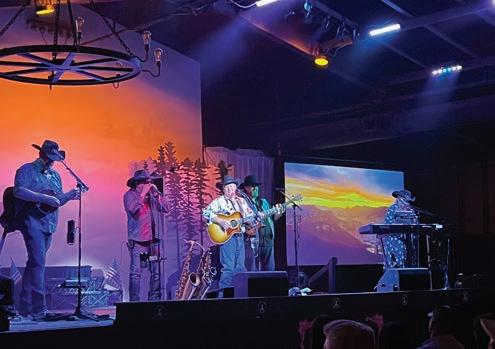

I had met band member Greg Pendley, a guitarist and vocalist, the day before, when I stumbled upon the lunchtime Cody Rotary Club meeting at the Irma Hotel. Hearing that I was a travel writer, Greg offered me a pass to the show, but I thanked him and explained that our group was already signed up for the following evening. Turns out that Greg, a native of Cody who has been a Rotary member since 1987 (he beat me by two years), is also the owner of the Cody Cattle Company. It was just one lesson I learned that in small-town Cody (population 10,240), everyone knows each other, and people wear multiple hats. They also support one another, and maybe that’s how they make it through the winters. As I write this, it’s snowing in Cody, and the 20-degree temperature is heading down to 6 tonight.
The show was outstanding, with Martin, a past Western Music Association Instrumentalist of the Year and champion flat-pick guitar player, backed by guitars, fiddles and piano (played by Greg’s wife, Ann Pendley) and the perfect harmonies of the Cowboys. “The Devil Went Down to Georgia” was a rousing fiddle competition, and the tribute to Johnny Cash including “Folsom City Blues” was a highlight. You can check out the group on YouTube.
We arrived at Stampede Park about an hour before the 8 p.m. show, allowing plenty of time to have our pictures taken astride Norman the Bull, and chat with some of the local cowboys and cowgirls.
Inside the arena I gazed out at the two facing grandstands, both packed on this opening night, and paused to drink in the beauty of the setting. The rolling foothills of the Absaroka range surrounded the stadium and were bathed in stunning sunset hues.
The rodeo got underway with a memorable horseback presentation of colors and the singing of the National Anthem. Then we were off with saddle bronc riding. I learned that riders must stay astride their horse for a full eight seconds to have their ride count. I really enjoyed the cowgirls’ barrel racing, and the two-person team roping. Before the bull riding began, kids were invited to participate in the “calf scramble,” in which they attempt to grab red bandanas attached to calves’ tails.
Throughout the evening, friendly announcers, assisted by a resident clown, explained the rules for each competition, so it’s easy for rodeo novices like me to follow – and get caught up in – the action. You can also walk over to the cowboys and cowgirls and chat with them as they wait for their events.
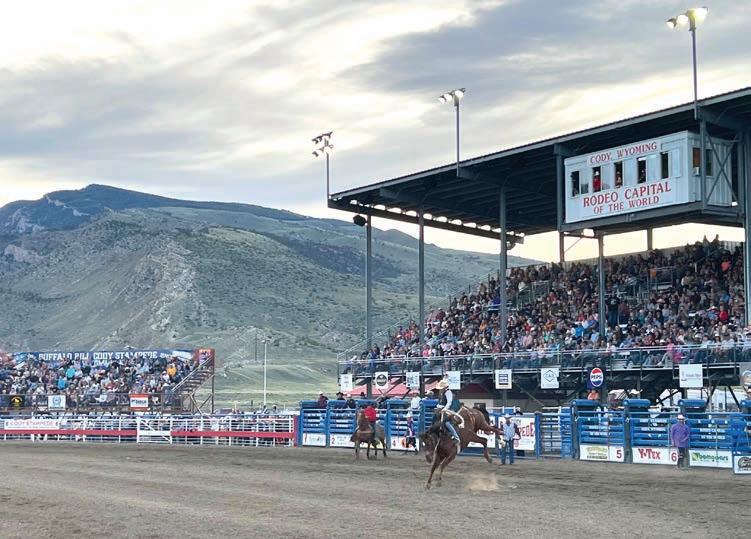
Cody’s rodeo roots trace back more than a century, to the town’s founder, William Cody, aka, Buffalo Bill. Although he never brought an official Wild West show to his namesake town, Buffalo Bill did hold rodeo tryouts for the show behind his Irma Hotel at what is now the hotel’s parking lot.
Cody died in 1917, but locals continued his legacy by promoting rodeo events. In 1919 local promoter and former stagecoach driver Clarence Williams organized an “Entrance Day Rodeo” in conjunction with the annual opening of Yellowstone Park’s East Entrance to motor vehicles. The following year the rodeo was named the Cody Stampede and moved to 4th of July weekend where it has remained ever since.
On August 6, 1938, Carly Downing, who in her earlier years had been a trick rider in Buffalo Bill’s Wild West Show, introduced a nightly rodeo. Originally called the “Pup Rodeo,” it has long since been a draw for beginner cowboys and cowgirls as well as seasoned cowboys who found time on their hands between events on the professional rodeo circuit.
On our way to the Stampede arena, our tour bus passed Old Trail Town, visible just off the highway and located on the original town site of Cody City.
On my next visit I’ll stop here to explore its 28 historic buildings including Butch Cassidy’s Hole in the Wall Cabin and Jeremiah Johnston’s grave. Yes, there really was a Jeremiah Johnston, and his life was far more controversial – ferocious, actually – than that depicted in the 1972 film. Still, during the 1974 reinterment when Johnston’s gravesite was moved from Los Angeles to Cody, Robert Redford served as one of the pallbearers.
The Buffalo Bill Center of the West
It’s a good thing that your admission ticket to this Smithsonian-affiliated institution is good for two days because it’s nearly impossible to cover it all in one. The Center houses five museums under one roof, including:
The Buffalo Bill Museum is a western history museum about the museum’s namesake, as well as some of the biggest characters in the West like Annie Oakley, Sitting Bull, Pawnee Bill, and other members of the Wild West Show. It includes actual footage of his shows, giant promotional murals, costumes, saddles. At the rotunda entrance is a diorama of bison, which marked the beginnings of Cody’s fame.
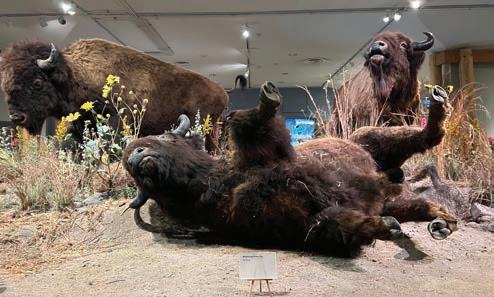
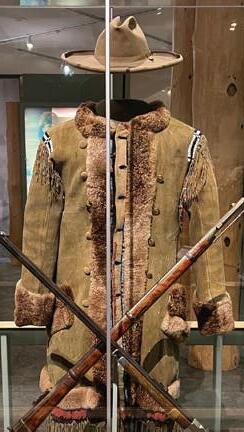
Buffalo Bill knew more about branding than today’s multi-million marketing firms, and visitors can see firsthand how Cody crafted his image, blending fact with fiction to create an enduring legacy. Among notable items on display are Cody’s personal firearms, saddles and outfits he wore during his performances. There’s an authentic stagecoach and equipment used by his traveling troupe.
The Whitney Western Art Museum houses numerous works from renowned traditional artists including Charles Russell, Frederic Remington, Thomas Moran, Albert Bierstadt, as well as other traditional and contemporary artists. The Cody Firearms Museum features over 7,000 firearms and related artifacts. It showcases the evolution of firearms from early muskets to modern weapons, and includes pieces from iconic manufacturers such as Colt, Winchester and Remington.
The Plains Indian Museum houses one of the nation’s largest collections of Native American art and artifacts. It provides a deeper understanding of the diverse Plains Indian tribes including the Lakota, Cheyenne, Absáalooka, Arapaho and Nez Perce. It doesn’t shy away from presenting the profound changes these tribes faced due to westward expansion, government policies and forced assimilation.
The Draper Natural History Museum offers an immersive experience into the Greater Yellowstone ecosystem, guiding visitors through interconnected exhibits that follow a winding downward spiral from alpine peaks to the valley floor. Interactive displays and lifelike dioramas highlight species such as grizzly bears, wolves, bison and elk, emphasizing their roles in a delicate ecosystem.
The Draper Museum Raptor Experience features daily programs from March through November with live birds including a bald and a golden eagle, a turkey vulture, a peregrine falcon, a red-tailed hawk, owls and other birds of prey.
During the months of June, July, and August on Mondays, Tuesdays, Thursdays and Fridays, you can book a family-friendly Chuckwagon dinner, cooked outdoors while you watch. The meals are prepared by 2 Mules Chuckwagon dinners, and I can tell you they can whip up some mighty fine eating in their Dutch ovens. (They served us at our opening night reception at the K3 Guest Ranch Bed and Breakfast.) Book the dinners in advance by calling (307) 899-2027.
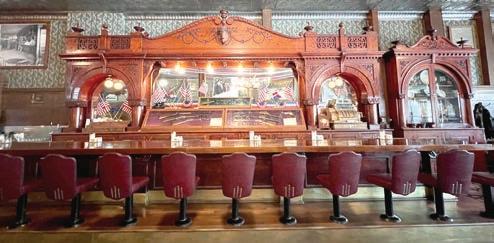
William Cody (1846–1917) was born in LeClaire, Iowa. You may remember my references to him in the story I wrote a year ago on the Quad Cities, where another museum, the Buffalo Bill Museum, also bears his name. But the Center in Cody holds the great majority of his Wild West memorabilia and personal records.
Cody spent his teens as a Pony Express rider and army scout, and in his thirties became known as a legendary buffalo hunter.
He made his stage debut in 1872 and founded his legendary Wild West show in 1883. He was in many ways the world’s first international “superstar,” immediately recognizable from his flowing white hair, trademark goatee and mustache, Stetson hat, buckskin jacket and leather boots.
For 30 years, his show traveled across the United States and Canada. In May 1887, Buffalo Bill and his cast of 800 performed in London as part of the Golden Jubilee of Queen Victoria’s 50 years on the throne. He was subsequently invited to give a Command Performance for the Queen, her first public entertainment since the death of her husband, Prince Albert, who died in December 1861.

From Buffalo Bill’s own account of the performance:
“As usual in our entertainment, the American flag, carried by a graceful, wellmounted horseman, was introduced, with the statement that it was “an emblem of peace and friendship to all the world.”
As the standard-bearer waved the proud emblem above his head, Her Majesty rose from her seat and bowed deeply and impressively towards the banner. The whole court party rose, the ladies bowed, the generals present saluted, and the English noblemen took off their hats. Then—we couldn’t help it—but there arose such a genuine heart-stirring American yell from our company as seemed to shake the sky. It was a great event. For the first time in history, since the Declaration of Independence, a sovereign of Great Britain had saluted the star spangled banner, and that banner was carried by a member of Buffalo Bill’s Wild West! All present were constrained to feel that here was an outward and visible sign of the extinction of that mutual prejudice, sometimes almost amounting to race hatred, that has severed the two nations from the times of Washington and George the Third to the present day. We felt that the hatchet was buried at last and the Wild West had been at the funeral.”
Indeed, Queen Victoria was captivated by Buffalo Bill’s romanticized portrayal of the American West. He met with the Queen again in 1892, when he brought his Wild West Show back to London.
She gifted him with a cherrywood bar for his new hotel, the Irma, named after his daughter, which opened in 1902. The piece features beautifully carved wood with intricate scrollwork, columns and arches accented by mirrors.
A bison head peers out from the center arch. It remains a focal point at the hotel’s restaurant.

Along the Shoshone River
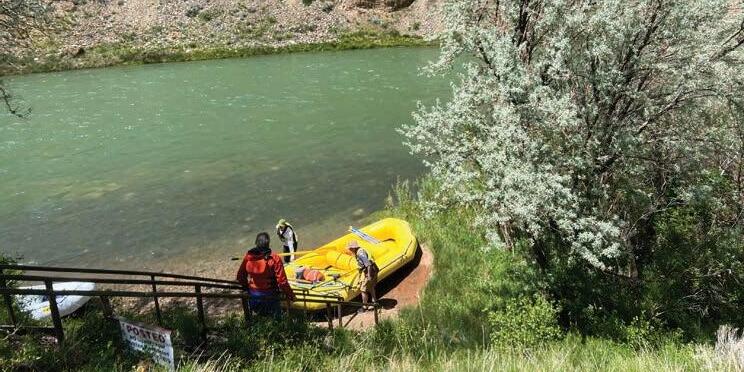
The 100-mile-long Shoshone River, with its headwaters in the rugged Absaroka Mountains, has always been a mighty river, propelled from tremendous mountain runoff in the summer months, and running through the Bighorn Basin, which eventually included the towns of Cody, Powell, Byron and Lovell. Could it ever be tamed?
I’m so glad that our tour hosts took us six miles west of Cody to the Buffalo Bill Dam and Visitor Center. The ride out there through the Shoshone Canyon, with the river gorge running hundreds of feet below the Yellowstone Highway, offers stunning scenery. And when you arrive at the dam, you can walk out over its entire length, taking in the power plant and Shoshone Canyon to the East, and the Buffalo Bill Reservoir to the west, with driftwood lapping at the walls of the dam. That wood is hauled out by crane each year.
There’s an excellent Visitor Center at the entrance to the dam, well stocked with books on the history of the area and the building of the dam. There’s also a mini theatre with a continuously running film with actual photography of the dam’s construction.
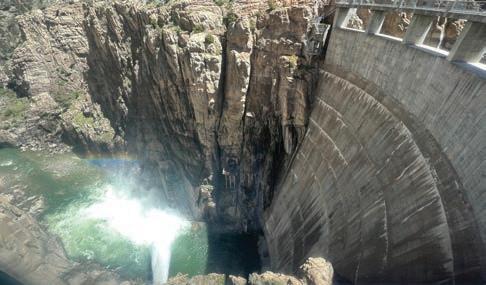
Back in 1910 when the dam was completed, it was 325 feet in height and claimed the title of the tallest dam in the world. It was also the first concrete arch dam in the United States It was then, and is today, a marvel. No wonder it was listed on the National Register of Historic Places within the first five years of the register’s completion. In 1993, the crest of the dam was raised, adding a needed 260,000-acre feet of storage capacity in Buffalo Bill Reservoir, and the current visitor center opened.
It kind of reminded me of a miniHoover Dam. It was, in fact, a prototype for the building of the larger Boulder Dam that was constructed some 20 years later during the Depression and renamed Hoover Dam in 1947.
The building of the Buffalo Bill Dam transformed the desert sagebrush landscape of the Bighorn Basin, one of the driest areas of Wyoming, into a fertile valley where crops could flourish, and settlers would be attracted to the area.
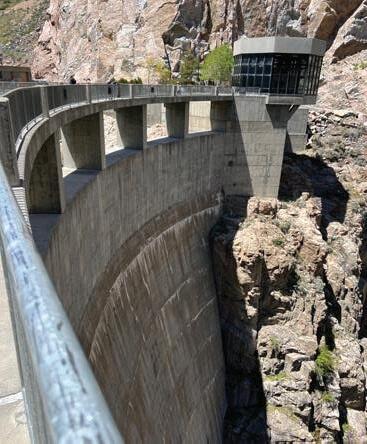
One of the visionaries was none other than William F. “Buffalo Bill” Cody who founded the town of Cody and owned much of the land in the Bighorn Basin. He gathered investors to form the Shoshone Land and Irrigation Company and acquired water rights to irrigate 60,000 acres of land. When the state of Wyoming found building costs for the Shoshone Dam, tunnels, canals and diversion dams beyond its means, Cody and his investor group turned their water rights over to the Secretary of the Interior. Exploratory drilling began in 1904 on the Shoshone Dam. It was renamed in Cody’s honor in 1946, commemorating the 100th anniversary of his birth.
It was a miracle that the dam was ever built. Working conditions were so awful that laborers went on strike – it marked Wyoming’s first labor strike.
Part of the problem was the geography of the area. The Shoshone drained such a mountainous area that it created a flow that was rapid and powerful, particularly hazardous in the summertime when winter runoff roared downstream, bringing boulders and uprooting trees.
In the summer of 1908, the runoff was so high that it flooded the dam’s foundation pit and workers had to start from scratch. The other problem was the intense cold weather. When workers poured the last bucket of concrete on Jan. 15, 1910, temperatures reached 15 degrees below zero.
Yet they persevered and succeeded.
Another way to explore the Shoshone is by rafting its waters and multiple rafting and kayaking companies in Cody are at the ready. Our group went out with Wyoming River Trips. At the main office we learned safety procedures and donned optional weather-proof clothing, both for our upper and lower bodies that slid over our regular clothes. It was a fairly nice day, so I opted for just the uppers.
Next, we were all outfitted with bright orange lifesaving vests and when properly attired, we were transported by van to the “put in” site on the river. Our group took up three rafts, about eight of us per raft. Our guide helped us onto the thwarts, which are cross-tubes filled with air that give the raft some structural rigidity and serve as seats. He advised that anyone sitting on the front thwart would definitely get wet; the rest of us, maybe.
We were then handed paddles; yes, this would be a group effort and in some parts of the river, we would all need to pitch in to steer clear of rapids. We were advised that most of the two-hour tour (why do visions of Gilligan float in my mind?) would be along gentle Class One rapids, and a short area of Class Two’s. Off we went, in cool waters flanked by red canyon walls. We were out in the wilderness, floating lazily, watching the world pass by. Then came that short stint of Class Two rapids. That’s when I learned that not getting the protective clothing on my lower half was a mistake. We all got soaked.
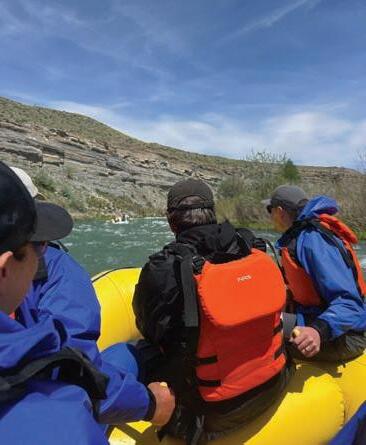
Yellowstone – The Land of Fire and Ice
Way back in 1870, The WashburnLangford-Doane Expedition played a crucial role in Yellowstone’s formation, with the group’s participants mapping the area and documenting its unique geothermal features. Geologist Ferdinand Hayden, railroad financier Jay Cooke, artist Thomas Moran and photographer William Henry Jackson helped sway Congress and public opinion that this land was worth saving from development, preserving it for the enjoyment of all Americans, and indeed, the world.
On March 1, 1872, Congress passed the Yellowstone National Park Protection Act and President Ulysses S. Grant signed it into law, thereby establishing the first national park in the world.
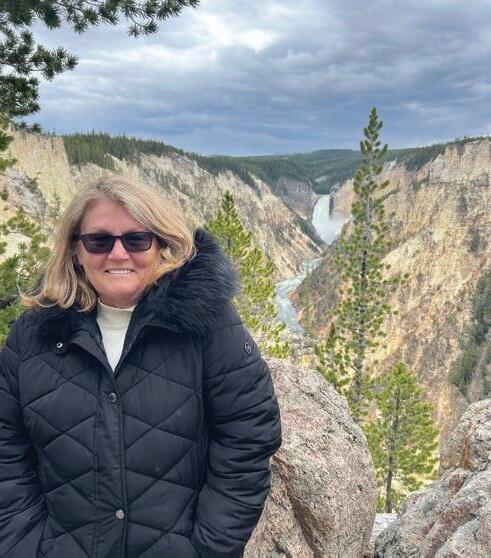
On March 1, 1872, Congress passed the Yellowstone National Park Protection Act and President Ulysses S. Grant signed it into law, thereby establishing the first national park in the world.
Two of Yellowstone’s five entrances can be accessed from Cody. Our group made a full-day tour on two large Yellowstone motor coaches, entering the park through the northeast entrance, about 70 miles from Cody’s downtown. The entrance connects with the Beartooth Highway, perhaps the most scenic drive in America.
As we drove through the Lamar Valley, often referred to as the “Serengeti of North America” due to its abundant wildlife, we did indeed see hundreds of bison and a few bears and pronghorns. Today, bison, once almost extinct in America, number about 4,800 in Yellowstone.
It was easy to know when they were close to the road because our bus driver would alert us to a plethora of parked cars up ahead, sometimes congesting the road. And despite warnings that people should give bison a wide berth of at least 25 yards, we were repeatedly astounded to see people standing just a few feet away with cameras and tripods.
We lunched at the Mammoth Hot Springs Hotel, built in 1936 and featuring Art Deco design. Mammoth Hot Springs is famous for its terraced limestone formations, created by thermal water flowing from underground. Visitors can explore these formations via a network
of boardwalks, offering closeup views of the steaming, colorful deposits. Beyond the terraces, the Historic Fort Yellowstone, built in the 1800s, offers a glimpse into the park’s early days when the U.S. Army managed it.of boardwalks, offering closeup views of the steaming, colorful deposits. Beyond the terraces, the Historic Fort Yellowstone, built in the 1800s, offers a glimpse into the park’s early days when the U.S. Army managed it.of boardwalks, offering closeup views of the steaming, colorful deposits. Beyond the terraces, the Historic Fort Yellowstone, built in the 1800s, offers a glimpse into the park’s early days when the U.S. Army managed it.
of boardwalks, offering closeup views of the steaming, colorful deposits. Beyond the terraces, the Historic Fort Yellowstone, built in the 1800s, offers a glimpse into the park’s early days when the U.S. Army managed it.
We followed the highway along the Yellowstone River, the longest undammed river in the United States. Our next stop was one of the viewpoints overlooking the Grand Canyon of the Yellowstone, one of the park’s most breathtaking sites. Carved by the Yellowstone River, the canyon stretches 20 miles long, reaching depths of 1,000 feet. It features two stunning waterfalls, Upper Falls (a 109-foot drop) and Lower Falls (a 308-foot drop), with multiple viewpoints.
We passed over the historic “Fishing Bridge” at the north end of Yellowstone Lake, which is North America’s largest mountain lake above 7,000-foot altitude and the outlet for the Yellowstone River. The lake is 20 miles long and 14 miles wide. Although fishing from the bridge was outlawed in 1973, it offers an excellent view of trout spawning shows, with White Pelicans feeding on the native cutthroat trout as they spawn.
Old Faithful, the world’s best-known geyser, was not on this trip’s itinerary, as it is in the proximity of Jackson, Wyoming and most easily accessible from Yellowstone’s South Entrance. On my earlier trip to the park, I watched the geyser spout an average of every 93 minutes (although the range is 40 to 126 minutes), and toured the Old Faithful Inn, the most famous structure in any of the national parks. Designed by architect Robert Chambers Reamer, this “modern wilderness log cabin” used local logs and rocks in its construction and despite its indoor plumbing, steam heat and electricity, appeared to “have grown out of the landscape.” It opened on June 1,1904 and revolutionized park design.


We glanced upward at Cody Peak and Avalanche Peak, both towering over 10,000 feet as we crossed over Sylvan Pass (elevation 8,530 feet) and exited at the park’s east entrance at 6951 feet, with snow on the ground and ponds frozen over.
Worn out but warm in our motorcoach, we headed back to Cody, just 52 miles down the road.

Calling all city slickers….


Saddle up, my friends, I’ve got the perfect dude ranch for you. UXU Ranch is just 17 miles outside the east gate of Yellowstone, with stunning Rocky Mountain views all around. If you look up a listing of the most popular dude ranches in America, you’ll find UXU in the top twenty and it’s moving up each year.
I chatted with James “Slice” McLain, one of the wranglers at the ranch and my hero for quickly finding my cell phone when it bounced out of my pocket as my horse bounded down a slight hill just before a creek crossing.
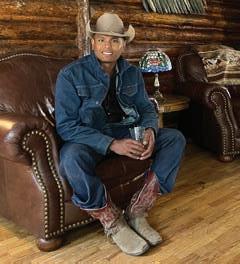
“Why do people choose UXU?” I asked him later in the day, although I was already sold on the experience, the scenery and staff.
“Four reasons in this order,” he said. “Horses, food, cabins, and grizzlies.”
I can attest to the draw of the first three. The ranch has a stable of some two dozen horses for all levels and you can opt to ride every day if you so please, although a typical week’s stay might include a welcome cocktail party with entertainment on Sunday, white water rafting on Monday and line dancing that night; horseback riding and fishing on Tuesday, a guided tour through Yellowstone on Wednesday, and horseback riding on Thursday followed by the Cody Nite Rodeo.
As for food, the ranch serves three hearty meals a day. We had delectable pork chops one night; tender beef brisket the next, both served familystyle with appetizers, salads, rolls and cobblers. Ranch hands, all spiffed up, joined us around the long wood table. Adjoining the main dining room is the Bad Bear Bar, and I can assure you that a cocktail after a day on the trail does goes down nicely.
Each of the 11 historic cabins date back to 1929, the first year UXU was a registered dude ranch, and one to 1898 when the ranch was a sawmill office. They’ve all been restored with rustic, cozy interiors and up-to-date amenities.
Now about those grizzlies. I was told not to go out alone after dark and to always look before rounding a corner. Happily, I saw no bears, but plenty of deer.
John “Grief” Hoskin, along with some partners, have owned UXU going on five years. He originally came to the area to photograph rodeos, and his exquisite fine art western photography can be viewed on his website, www.jlgrief.com.
Slice, meanwhile, has a degree in finance from Louisiana State University and spent a couple of years on Wall Street, and has some big plans. He currently spends fall, winter and spring at the 6666 Ranch in Texas: it’s famous for being owned by Taylor Sheridan, the writer for the series “Yellowstone” and being the Number One ranch in America for breeding quarter horses. (You can see the 6666 in action on Yellowstone’s season five, last episode.)
Along with fellow wrangler Maverick, Slice is on the lookout for land to establish his own ranch in Wyoming. “That’s what brought me to UXU,” he said, “to learn to ranch at the highest level.”
While he had considered Montana or Utah, he says, “I’m set on Wyoming. It’s the cowboy state. The true west.”
When You Go…
Getting there
You can fly into Yellowstone Regional Airport in Cody on United Airlines from Denver International Airport (four daily flights in the summer; two daily flights in the winter).
It’s about a 17-hour drive drove to Cody. I made overnight stops in Las Vegas, Nevada and Park City, Utah. The drive through Wyoming’s rural landscape on two-lane roads was memorable; I’ve never seen so many pronghorns, the fastest land mammal in America. I drove home by going north to Highway 90, and headed west to Washington, overnighting in Missoula, Montana and Coeur d’Alene, Idaho on my way to the Olympic Peninsula.
Cody YellowstoneThis is the marketing arm of Park County, Wyoming. The region includes the towns of Cody, Powell and Meeteetse, parts of the Shoshone National Forest and a large swath of Yellowstone National Park. Website has info on hotels, restaurants, shopping, suggested itineraries, events and attractions. www.codyyellowstone.org
Yellowstone National Park and LodgesReservations and information on lodging, dining and in-park activities such as trail rides boat tours and cookouts are operated by Xanterra Travel Collection: Reservations: (307) 344-7311 Info-ynp@xanterra.com www.yellowstonenationalparklodges.com
Entrance fees:
Vehicle, non-commercial: $35
Entrance fee is waived if you have a Yellowstone annual pass ($70); Senior annual pass ($20); U.S. Military annual pass (free) or Interagency pass (free).
Attractions & Experiences
North Fork AnglersOne-stop shop for all your fly-fishing needs1107 Sheridan Ave. www.northforkanglers.com
Buffalo Bill Center of the West 720 Sheridan Ave.www.centerofthewest.org
Cody Nite Rodeo (All summer long)
Cody Stampede Rodeo(over 4th of July weekend)Stampede Park; 519 W. Yellowstone Ave. www.codystampederodeo.com
Cody Firearms Experience/ Cody Firearms MuseumIndoor shooting range featuring replicas of guns throughout history. 143 W. Yellowstone Ave. www.codyfirearmsexperience.com
Wyoming River Trips233 Yellowstone Ave. www.wyomingrivertrips.comCody Trolley Tours 1192 Sheridan Ave.www.codetrolleytours.com
Buffalo Bill Dam and Visitor Center 4808 No. Fork Hwy, Cody Open May 1 – Sept. 30; Admission is free. www.bbdvc.com
Town of Meeteetse and Meeteetse Chocolatier
This postage-stamp-sized town still has wooden boardwalks, hitching posts and water troughs. But what’s really worth the 32-mile drive from Cody are Tim Kellogg’s Belgium chocolates, truffles and barks at Meeteetse Chocolatier. Be sure to call ahead to see if he’s open and get there early. www.meeteetsewy.com
Meeteetsechocolatier: (307) 868-2567 www.meeteetsechocolatier.com
Museums
Cody Country Art League836 Sheridan Avenuewww.codycountryartlleague.com
By Western Hands Museum & Gallery1007 12th Street www.bywesternhands.org
Heart Mountain WWII Interpretive CenterHear the story of this World War II relocation center for 14,000 Japanese citizens of the United States told by actual residents and their descendants. Through exhibits, photographs, personal testimonies and reconstructed barracks, the center provides a powerful account of resilience, civil rights and the impact of wartime policies. 1539 Road 19, Powell, WY www.heartmountain.org
Old Trail Town and Museum of the Old West 1831 Demaris Drive www.oldtrailtown.org
Lodging
Best Western Premier Ivy Inn & Suites 1800 8th St. www.bestwestern.com
Buffalo Bill’s Irma Hotel 1192 Sheridan Ave. www.irmahotel.com
Chamberlin Inn1032 12th Streetwww.chamberlininn.com
Holiday Inn at Buffalo Bill VillageResort 1701 Sheridan Ave. www.blairhotels.com
K3 Guest Ranch Bed & Breakfast30 Neilsen Trail, Cody, WY 82414 (307) 587-2080
UXU Ranch 1710 North Fork Hwy. www.uxuranch.com
Restaurants
The Blanca Tatanka1455 Sheridan Ave. www.theblancatatanka.com
Cody Steakhouse 1367 Sheridan Ave.www.codysteakhouse.com
The Cody Cattle CompanyFantastic dinner and show, next door to the rodeo grounds 1910 Demaris Street www.thecodycattlecompany.com
Irma Restaurant & Grill 1192 Sheridan Ave. www.irmahotel.com
Pat’s Brew House1019 15th St. www.patsbrewhousewy.com
Silver Dollar Bar & Grill1313 Sheridan Ave. (307) 527-7666










